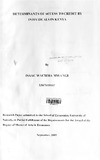Determinants of access to credit by individuals in Kenya
| dc.contributor.author | Mwangi, Isaac W | |
| dc.date.accessioned | 2012-11-13T12:35:36Z | |
| dc.date.available | 2012-11-13T12:35:36Z | |
| dc.date.issued | 2010 | |
| dc.identifier.uri | http://erepository.uonbi.ac.ke:8080/handle/123456789/5138 | |
| dc.description.abstract | Access to credit remains a farfetched goal to the vast majority in Kenya. This is despite the government efforts to deepen access through measures such as encouraging financial institutions to lower the lending rates. Over 75% of the total Kenyan population remain unbanked, with 49% of the banked accessing credit from friends and relatives. Viewed against the background of the growing evidence of the rising cost of living the reduced access becomes a matter of concern. Enhanced access to credit is crucial due to the immense role that it plays in smoothing the consumption behaviour of individuals while at the same time boosting investment. This in turn leads to a reduction in poverty levels. In furthering this goal the study tries to investigate the factors that either enhance or hinder access to credit by individuals. The study utilized the financial access 200612007 national survey data. Bivariate probit and multinomial logit models were estimated to investigate the factors that determine choice of'credit source by individuals in Kenya. Middle aged persons were observed to have more access to credit than the elderly, Their preference for formal credit was greater than that of informal credit. While financial institutions have for a very long time relied on credit rationing by using interest rates. there is need to change and instead make use offactors such as individual characteristics. Despite interest rates being high in formal institutions. access to credit from the formal financial institutions remained high. Distance to financial service provider was found to be a barrier to credit access from both the formal and informal sources. On the other hand education level and age 0.( individuals were found to contribute to increase in access to credit services. The study also established that women are more credit constrained than men. However since the study focused on access to credit from all sources. women were found to be more active in the credit market than men. There is need for the government to encourage increased productivity to raise the income 0.( individuals as income leads to increased access to credit. | en_US |
| dc.language.iso | en_US | en_US |
| dc.publisher | University of Nairobi, Kenya | en_US |
| dc.title | Determinants of access to credit by individuals in Kenya | en_US |
| dc.title.alternative | Thesis (MA) | en_US |
| dc.type | Thesis | en_US |

